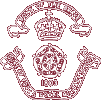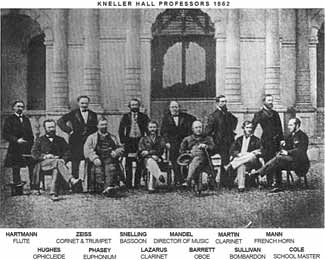


 |
 |
|
 |
||
| Navigation links at the bottom of this page |
| A seed bed of musicians |
Since the early days of its existence, the RMA as it was has produced a steady stream of musicians to fill the ranks of bands throughout the British Army always in need of musicians. For the majority of musicians from the RMA, once having left the school, nothing more is heard of them. They lived their lives in obscurity enjoying, one must hope, having been taught to play a musical instrument with some proficiency and contributing to the band or musical group of which they became part. Most left no record of their accomplishments, their contribution to musical life. A trace of them is to be found in the admission registers and among the 'petitions for admission' prepared by their guardians and recommended by the regimental officers of their fathers. Some musicians left a footprint in the sand on the tidal shore of history. Debroy Somers was one (1952 Debroy Somers) Thomas Sullivan, Henry Lazarus and Alfred Phasey were others. There might have been others. For those with the time to ponder, here is a photograph of the Directors of the Royal Military School of Music, Kneller Hall, taken in 1862 when the art of photography was in its infancy. |
 |
At least three were ex-pupils of the RMA. One whose name strikes a chord in musical circles is Henry Lazarus, Professor of the clarinet, here seated in the front row third from the left. His reputation as the finest clarinetist in the 19th Century would not be disputed, his reputation as a virtuoso playing the clarinet concertos of Mozart, von Weber and Berlioz was well established. He was equally at home with the great clarinet concertos produced by the famed 'Mannheim School' of composers that included Tausch, Blasius, Danzi and Dimmler. His own legacy for future generations of clarinetists was not musical compositions to equal those of the Mannheim group of composers with whose works he was so familiar, but his celebrated clarinet tutor, still to be found in use today. Lazarus, born in London, was two months short of seven years of age when he entered the RMA in November 1821. His father was Pte Joseph Lazarus of the 27th Foot, the same regiment that supplied the first contingent of children to the Asylum when it opened 29 August 1803. Both parents were alive when Henry was admitted to the RMA, which suggests that his parents were in straightened circumstances at the time. His father might have been suffering from wounds suffered during the French Wars (1793-1815), although this is no more than speculation. Henry Lazarus must have done well at school, either as a student or a musician or both, because Colonel James Williamson, second commandant of the school, engaged him in the capacity of servant. Knowing something of the personality of Lt. Colonel Williamson from his record (he was the younger brother of the first commandant of the School, Lt. Colonel George Williamson, equally dedicated to the children under his care), it is reasonable to suppose that James Williamson took young Lazarus into his family as a servant to allow him more time to practice the clarinet. Whatever the circumstances, the young clarinet player did well with the results that are now well known in musical circles. In the 1881 census, Lazarus is recorded as living in Kensington and, at the age of 66, still having the occupation of Professor of Music. His son, George F. Lazarus, age 34, a clerk, and E. Bouldon, a female housekeeper were living at the same premises. This suggests that Henry's wife was probably deceased; either that of divorced or separated. Professor Sullivan, seated in the front row second from the right, taught the Bombardon (more commonly known as the E flat bass). Sullivan was the father of Sir Arthur Sullivan, collaborator with Gilbert in the creation of the Savoy Operas. Thomas Sullivan, Arthur Sullivan's father, was nine years of age when he was admitted to the Asylum. He was the son of Pte Thomas of the 57th Foot and his wife, Mary Sullivan. Both parents were alive when Thomas Sullivan was admitted to the RMA. Then, at age 14, he went to the Royal Military College, Sandhurst. In 1919, the year of his enlistment, he would have gone to Sandhurst not as a cadet for officer training, but on boy service as, quite evidently considering the outcome, a musician in the RMC band. In time, he became the RMC bandmaster. From that position, he transferred to the Royal Army College of Music, Kneller Hall, as professor of the bombardon. Professor Phasey, seated next to Hughes in the front row, identified as 'Professor of the...' Euphonium is Alfred James Phasey, who joined the RMA at age 5 years and 7 months 23 September 1839. His father was Pte Thomas Phasey of the Grenadier Guards, his mother Elizabeth Phasey. Both parents were alive at the time. Alfred James enlisted in the Coldstream Guards at age 15 on 7 August 1849. His was an exceedingly young age at which to have specialized at the Hall. Phasey is the subject of a separate article in this history section of the Duke of York's (see 1888 Professor A. J. Phasey). Of the remaining figures in the group, it is not known with certainty who else might have been former students of the RMA although we know for certain those who were not boys of the Chelsea school because their names do not appear in the admissions registers. They include professors Hartmann, Zeiss, Snell, Mandel, Barnett, Hughes and Cole, the school master. There is less certainty about the RMA experience of professors Martin and Mann because first names are omitted from the identifying captions tags under the photograph. The admissions register was consulted in an effort to make a positive identification. Eight Martins are listed in the admissions register. Two were brothers, aged six and eight, the sons of a Pte Martin of the 3rd Dragoons, but as they were shown to have been 'returned to their parents' at age 14, they are eliminated as candidates. Another two brothers, Andrew and George, seven and five years of age on admission, also from the 3rd Dragoons, were 'delivered to their parents'. A fifth boy, William Martin from the 25th Foot was indentured to a shoe maker. If is not possible to say if any of Martins on the admissions register could qualify for the Professor Martin in the photograph. There is a similar problem with positively identifying Professor Mann who taught the French Horn. The first four Manns listed are ruled out as having died or 'delivered to their parents'. Further, Manns on the record after 1833 would have been too young to be in the photograph. This leaves James Mann, a near contemporary of Sullivan and Lazarus. He joined the school in 1808, but no disposition is shown in the discharge column of the register, which is insufficient to indicate his subsequent career on leaving the institution. |
| ||||||||||
|
© A. W. Cockerill 2011 Site Map Contact me | ||||||||||